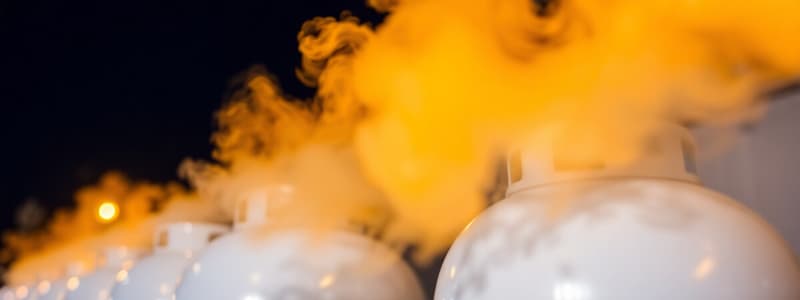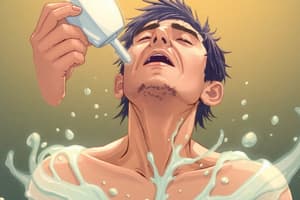Podcast
Questions and Answers
What is the primary method for detecting natural gas and propane?
What is the primary method for detecting natural gas and propane?
- Relying on visual inspection
- Feeling for gas leakage with hands
- Using a calibrated sense of smell
- Using equipment specifically designed for detection (correct)
Which chemical is associated with the odor of natural gas?
Which chemical is associated with the odor of natural gas?
- Isopropyl alcohol
- Chlorine gas
- Methyl Mercaptan (correct)
- Ethyl Mercaptan
What is the effect of odor fade in natural gas and propane?
What is the effect of odor fade in natural gas and propane?
- Absorption or oxidation in various materials (correct)
- Permanent loss of the odorant's properties
- Enhanced smell of rotten eggs
- Increased odor detection ability over time
Under what conditions does liquid propane gas become vapor?
Under what conditions does liquid propane gas become vapor?
What is a significant consideration when using gas detection meters?
What is a significant consideration when using gas detection meters?
Flashcards are hidden until you start studying
Study Notes
Detection of Natural Gas and Propane
- Equipment should be used to detect natural gas and propane rather than relying on smell.
- Daily calibration of detection meters is essential for accurate readings.
- Odorant may dissipate into various building materials like soil, concrete, and drywall.
Odorants Used
- Methyl mercaptan is the odorant for natural gas.
- Ethyl mercaptan is the odorant for propane.
- Both odorants have a distinctive smell similar to rotten eggs or cabbage.
Odor Fade
- Occurs through absorption or oxidation processes.
- More prevalent in newer, larger steel pipes and tanks, as well as polyethylene materials.
Reducing Odor Fade
- Conditioning of equipment is recommended to minimize odor fade.
Propane Specifics
- Chemical formula: C3H8
- UN ID number: 1075
- Emergency Response Guide (ERG) reference: Guide 115
- Liquid propane is used in vehicles.
- Propane is 1.5 times heavier than air, posing risks of simple asphyxiation.
Vapor Characteristics
- Liquid propane gas (LPG) vaporizes at -44°F.
- 1 gallon of LPG can produce 270 gallons of vapor.
- A home grill using 4.75 gallons of LPG can generate a vapor cloud of 1,274 gallons.
- Vapor can extend beyond the visible cloud.
Meter Usage Guidelines
- Suggested meter: Ventis 3 gas detector.
- Multi-gas detection should multiply Lower Explosive Limit (LEL) value by 2.
- Use the meter slowly and at low levels to collect softball-sized samples.
- A low O2 sensor indicates an air deficiency.
- If one or multiple sensors trigger alarms, consider activating Hazmat protocols.
Studying That Suits You
Use AI to generate personalized quizzes and flashcards to suit your learning preferences.




